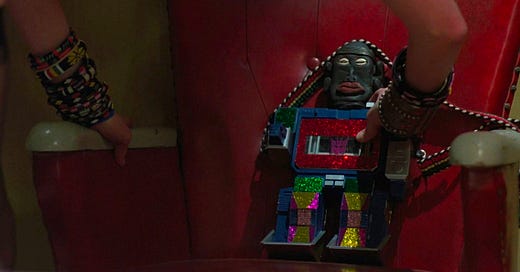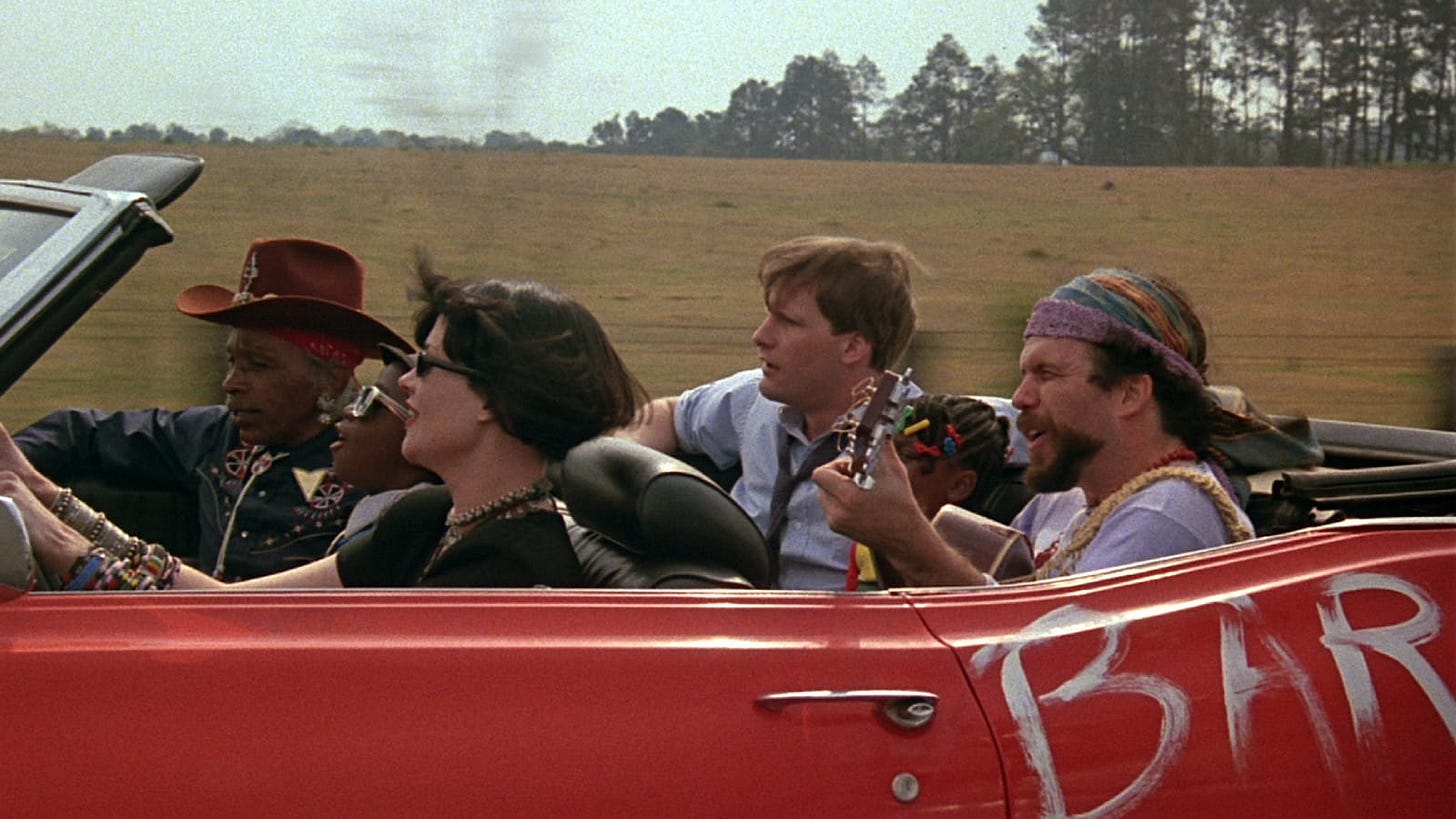The Music of Something Wild (1986)
From 2017: An appreciation of Jonathan Demme's anarcho-screwball classic and the globetrotting soundtrack that gives it shape.
Good morning, MTWZ readers.
Today’s post is the newsletter’s first, proper piece of analytical film writing. As distinct from a capsule blurb or typical review, this sort of piece advances an argument with evidence, illustrated inline through clips and stills, and thus is best applied to something I have watched multiple times. This kind of analysis takes more time to write than an evaluative review, so I don’t expect to be churning these out on a weekly basis. (By the same token, expect breezier new release coverage here soon.) But if you like what’s below, I’ll strive to provide more analyses of this sort in the future.
As I said in my inaugural post, I make no promises as to the quality of this newsletter. But in today’s case, I can plainly state, with receipts, that a truly random assortment of people have already told me this one is good. That is because I originally wrote this essay—on the soundtrack to Jonathan Demme’s 1986 comedy Something Wild (1986)—in 2017, as program notes for a September 30 screening of the film at Madison’s UW-Cinematheque.
For reasons I remain unsure of, and have been trying to reverse-engineer since, a bunch of people reached out to tell me I did alright on this one. For awhile, too, the SEO-friendly title (reprinted above) boosted the essay to one of the first search results if you Googled “something wild music” or “...soundtrack.” It enjoyed a minor afterlife of plugs on Twitter and Facebook. Someone emailed me in 2023 inquiring about the piece, and we had a brief exchange discussing John Cale and Laurie Anderson’s score from the film. Whatever the reason, the piece got around.
Because the original essay is no longer accessible online, I would like to post it here. I rewrote a few sentences, reformatted the text, and included extra illustrations below, but otherwise kept the piece intact, which includes maintaining its 2017-specific language (e.g., seen in the language referring to Demme’s death). As I would like it to remain widely available, this piece will be kept public in perpetuity. You can currently stream Something Wild on Criterion Channel or Tubi.
Please subscribe above to ensure you don’t miss the next Movie Time With Zach newsletter. You will find more analytical work of this sort in MTWZ issues ahead.
Eight years before Pulp Fiction’s soundtrack climbed the Billboard 200, Jonathan Demme’s Something Wild (1986) advanced, to less immediate acclaim, the art of the pop music soundtrack. Few movies before or since match it in terms of sheer volume of songs, and even fewer rival the internal diversity of its selections, from unique artists, genres, and countries of origin.
At last month’s BAM Cinema series commemorating Demme, who died in April, Paul Thomas Anderson marveled at the soundtrack’s scope:
[It] was historic how much music was in that movie. Watching it again, it’s there and it does everything, but it doesn’t overpower it. There’s all these long silences, too. I still can’t figure out how he did it.
By associating certain tones, locations, and story acts with distinct musical styles, Demme—in tandem with music supervisors Sharon Boyle and Gary Goetzman, composers John Cale and Laurie Anderson, and music editor Suzana Perlic—managed to squeeze over fifty songs into this romantic comedy/neo-noir/road trip movie, and in the process give shape to this highly elastic concept.
Following the impromptu journey of square Charlie (Jeff Daniels) and chic Audrey (Melanie Griffith, who first goes by “Lulu”) from New York City to Pennsylvania, Virginia, and back, Something Wild spends significant time in top-down cars with cranked-up radios, like American Graffiti (1973) before it. As with George Lucas’s film, one can detect in Something Wild’s soundtrack a personality behind its curation, but here the range of musical genres, the largely contemporary vintage of the tracks, and the organizing principles behind their arrangement showcase Demme’s famously democratic sensibility.
With his effortless, quintessentially American style, Demme mastered, and thus obscured, the technical nightmares underlying his projects. For Something Wild, Demme assumed the formidable challenge of sourcing nearly all the film’s music to the story world, making the songs “diegetic.”1 This self-imposed rule comes across not as overindulgence but—to paraphrase one of Demme’s heroes, Jean Renoir—as a way of keeping one door always open to the outside world.
To witness this principle in practice, just look and listen to the film’s opening titles (clip above). Against the climbing percussion, vocals, and brass of “Loco de amor (Crazy for Love)”—David Byrne and Celia Cruz’s salsa riff on the Troggs’ “Wild Thing”—we see morning dawn on Manhattan from the view of the rivers and harbor surrounding it. Before commencing the story proper, Demme grounds the song in the film’s world with a shot of a man holding a boombox in the middle of Lower Manhattan; “Loco de Amor” fades out accordingly as the man crosses the street, catty-corner to the café where Charlie and Audrey meet-cute.2 “Loco de amor” in turn impresses the thematic importance (recall the film’s title) of the Troggs’ British Invasion classic, which is sung three more times by characters during lax moments of harmony.
The first act of the film—a 25-minute run from opening titles to the first nightfall—breezes by with an exuberant, wall-to-wall mix of world music. Including “Loco de amor,” ten songs fill the sonic space, mostly via car radios, and all but three hail from Latin America or Africa. These include the following:
Over the café radio, “Si Por Mi Llueve” by Puerto Rican salsa singer Cheo Feliciano;
In the Holland Tunnel, “Wozani Mahipi (Hippies Come to Soweto),” by Mahotella Queens, leading practitioners of South Africa’s mbaqanga style;
On the New Jersey Turnpike, “Feel It” by Jamaican deejay Big Youth;
To greet Charlie and Audrey’s first kiss, Nigerian pop star Sonny Okosun’s “Highlife”;
And to kick off Charlie and Audrey’s motel rendezvous, “Ooh! Aah!” by Jamaican reggae group Fabulous Five Inc. You can’t miss this song’s diegetic source: a bedazzled tape player resembling an ancient African Transformer (see lead image at top).
Aside from “Wild Thing,” the only notable “continental” selection in this opening stretch comes when Charlie flees an unpaid bill and an irate Charles Napier: Big Audio Dynamite’s “Medicine Show,” which prominently samples Ennio Morricone’s theme from The Good, the Bad and The Ugly, cheers this moment of coerced lawlessness.
After a tellingly pop music-free interlude at Audrey’s mother’s house, Charlie and Audrey arrive at her Pennsylvania high school reunion, which is surely one of the most graceful sequences of Demme’s career. Introduced on-stage with a loving, star-spangled tracking shot, New Jersey college rock legends The Feelies perform a set of covers and originals as Charlie and Audrey, on the dance floor, feel the first shivers of a deeper attraction. Music supervisor Gary Goetzman3 joins the band on stage for a partly Spanish language rendition of Freddy Fender’s “Before the Next Teardrop Falls.” To a twitchy cover of Bowie’s “Fame,” Jeff Daniels commits to screen an indelible dance that defies notions of good or bad, and immediately after, The Feelies score the snakelike entrance of Ray (Ray Liotta), Audrey’s volatile ex, with their own “Loveless Love.” (See clip above.)
Once Ray takes over the literal and narrative wheel, the soundtrack turns toward punk (X’s “The New World,” to start) and new wave (Madison’s own Timbuk3, whose “The Future’s So Bright, I Gotta Wear Shades” plays at the first gas station). When reggae music returns, at a pivotal moment later at a diner, it comes in the hybrid form of “Zero, Zero Seven Charlie” by UB40 (hear above), a new wave-influenced reggae outfit from England—perhaps suggesting that some of Ray has rubbed onto Charlie.
But beyond defining character, Something Wild’s soundtrack creates a utopian sense of place (and taste), which is pure Demme: a Pennsylvania thrift shop in on the joke of, and otherwise enjoying, “Yahoo Eeee” by Wazmo Nariz; a group of Black men freestyle rapping outside of a Virginia gas station; a whole world ready to sing “Wild Thing,” from the heart.
The non-diegetic exceptions are Laurie Anderson and John Cale’s gentle, infrequent original score, as well as Jean-Michel Jarre’s eerie “Ethnicolor,” which accompanies a scene of climactic violence.
This first shot from street-level notably pans left, sharpening our attention against the opening series of shots, which all moved along the water in a rightward direction.
Goetzman also won an Oscar producing Demme’s The Silence of the Lambs (1991).
Coming up: Most of next week’s writing energy will be channeled to trying to get a pair of scholarly projects over the finish line, but you can still expect at least one MTWZ newsletter in the coming days. And if you like the piece above, I have a whole folder of out-of-circulation film writing that I would love to share here.





